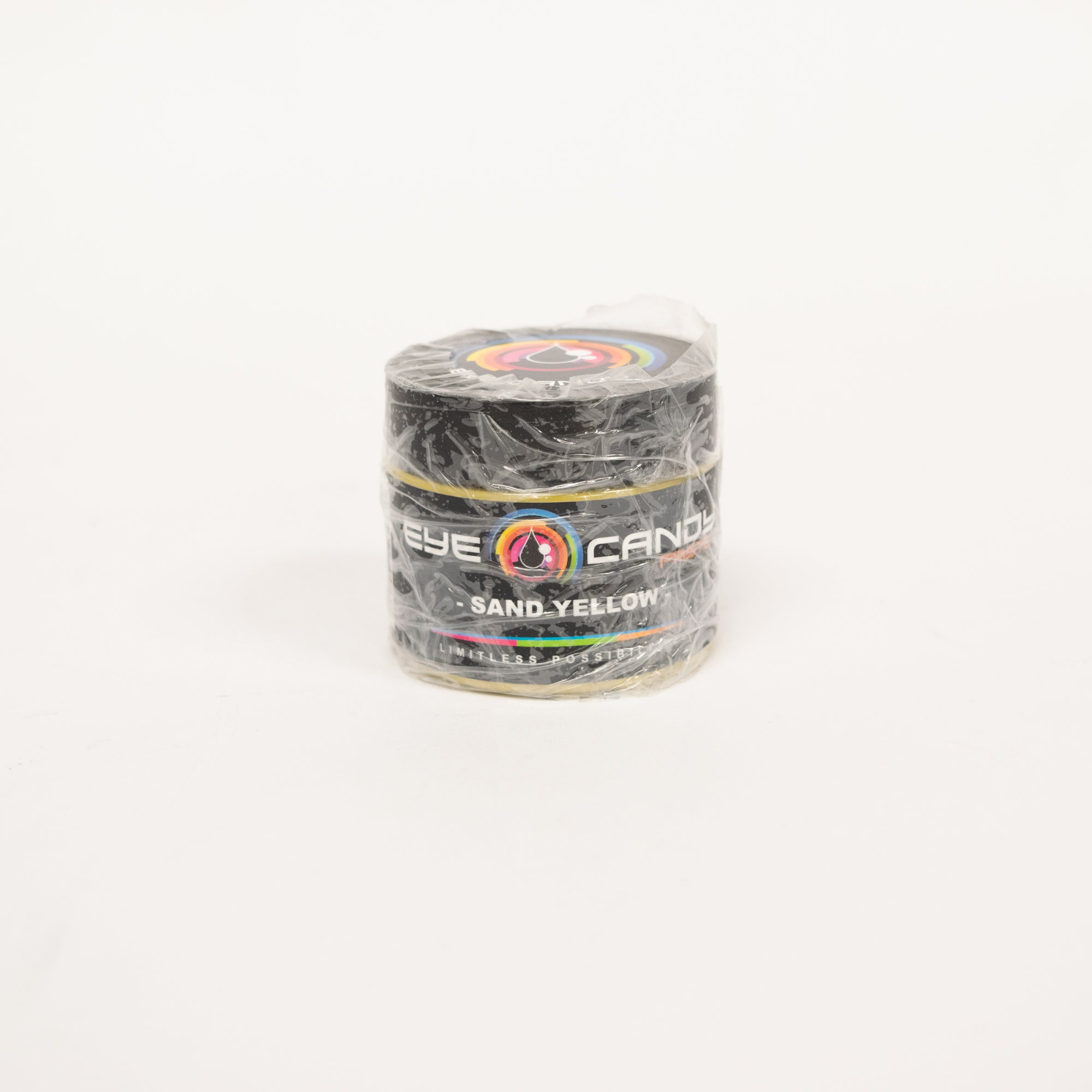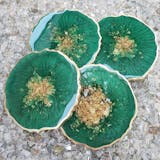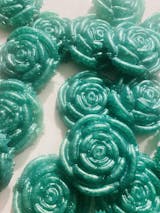Dive into the depth of Emerald Green, a profound deep green pigment that resonates elegance and creativity. Its rich shade guarantees a standout appearance in any project, infusing life and vitality. Perfectly suited for diverse applications, it melds well with mediums like epoxy resin and acrylic painting. Explore its beauty in slime, bath bombs, jewelry, melt & pour, plastics, and the warm glow of candles.
Particle size : 10-60 μm
Ingredients : Mica, Titanium Dioxide, Chromium Oxide
Heat Threshold : 392 °F - 572 °F
Product Type : Mica
Vegan : Yes
Soaps : Yes
Epoxy Resin : Yes
Acrylic : Yes
FDA-Permitted for External Use : Yes
FDA-Permitted for Eye Area Use : Yes
FDA-Permitted for General (Including Lips) Use : No
FDA-Permitted for Bath Bombs Use : No
Epoxy : 2 grams per 8 ounces
The most common question that we receive is “How much pigment per gallon of epoxy?” This is a very valid question and unfortunately there is no set answer due to the numerous types of applications and variations. This is why we recommend 2 grams per 8 oz and add as desired.
For example: Are you looking for an opaque or transparent look? Lighter colors may take more pigment to achieve the color.
Why micron sizes matter:
PLEASE be aware of the micron sizes of the pigment. The larger the micron, the larger the particle.
Typical pigments average 10-60um.
Be aware that larger micron sized pigments will most likely have a heavier density which will cause the pigment to sink faster in fresh epoxy such as deep pours. For example, our Icicle or 14k Nugget Gold is 200-700um and will most likely sink in fresh epoxy faster. To alleviate sinking either let the epoxy settle up a little bit. Or, come back through your project to “stir” it a little more.
Cold process - 2 tsp per lb of oils
Hot process - ½ tsp lb of MP base
Peelable Automotive Coatings (Plasti Dip, HaloEFX, P1Coatings, Pro Line, Autoflex, Etc.) - 50 Grams Per Gallon
Standard Automotive Clears - 25 Grams Per Gallon
Appliance Paint And Coatings - 25 Grams Per Gallon
Architectural Coatings (Interior And Exterior) - 10-20% By Weight
Wall Paper And Other Architectural Paper Coatings - 1-5% By Weight
Peelable Coatings:
◦ The majority of our pigments can be sprayed through a 1.2 tip
◦ Be aware of the micron size. The larger the particle you may have to go to a larger tip.
◦ The pigments can be mixed with the base color or mixed into the clear and sprayed over the base color.
◦ The base color may impact the overall color of the pigment.
◦ Light colored pigments yellows, pinks, etc., we recommend using a white base or a like colored base.
◦ Dark colored pigments, we recommend using a black or dark colored base
Automotive Paint:
◦ The majority of our pigments can and have been used for automotive.
◦ The majority of our pigments can be sprayed through a 1.2 tip
◦ Three ways to use our pigments for spraying:
◦ Mix directly into the base color to create a unique blend
◦ Mix and spray with your mid clear over the base color
◦ Mix and spray with your top coat. Typically we do not recommend this due to the possibilities of striping. Also, we use the top coat as a UV
protector or possible sanding of the top coat, etc.
Courtesy from our friend Justin Salley.
For more tutorials, visit his Youtube page www.youtube.com/@justinsalleyart/
STEP #1 - MIX YOUR POURING MEDIUM
3 parts Behr8300 Deep Base Interior/Exterior Hi-Gloss Enamel. 1 part JOSONJA Polyurethane Water Based Gloss Varnish. Mix gently folding paint and varnish together until they are completely mixed, Go Slow to reduce mixing bubbles.
STEP #2 - DISPERSING PIGMENTS INTO YOUR MEDIUM
Pour 1/2 to 1 teaspoon of JOSONJA Gloss Varnish into mixing container. Add around a teaspoon of Pigment (I generally add a little more) into your container with the JOSONJA. Mix until all Pigments have dissolved into a liquid making sure to stir any clumps out at this time.
STEP #3 - COMBINING YOUR POURING MEDIUM & DISPERSED PIGMENTS
Add around 3 Tablespoons of Pouring medium into your Dispersed Pigments. Mix thoroughly, being slow and folding rather than whipping, this will minimize the air bubbles.
STEP #4 - WHAT IF?
◦ If your new mixed color seems to thick - Add a small amount of JOSONJA and stir until you reach the desired consistency.
◦ If your new mixed color seems to thin - Add a small amount of Behr8300 (ONLY) and stir until you reach the desired consistency.
Vinyl Wrap And Plastic Films - 5-10% By Weight
Plastic Bottles - 1-2% By Weight
Masterbatch - 10-30% By Weight
Plastic Resins - 0.2-0.5% By Weight
Rubber Polymers And Latex - 5-15% By Weight
Glass - 1-10% By Weight
Candles - 5-10% By Weight
Flexographic Inks (Packing Materials) - 15-25% By Weight
Offset Printing Ink - 5-10% By Weight
Screen Printing And Screen Inks - 10-30% By Weight
Textile Printing And Textile Inks And Pastes - 5-10% By Weight
Gravure Inks - 5-15% By Weight
Lotions - 1-5% By Weight
Lipstick And Pigmented Lipgloss - 5-10% By Weight
Eyeshadow - 15-80% By Weight
Nail Polish - 5-25% By Weight
Shampoo - 0.1-2% By Weight
Our pigments can be used for both Cerakote and KG Gunkote clears. Below are just some references.
◦ 5 grams of pigment per 4oz
◦ Typically recommend a black base. For light colored pigments such as
yellows, pinks, etc. you may want to try a light colored base. ALWAYS test before full application.
◦ 3 coats for full saturation. Some colors may require less.
◦ Stay with pigments with a 10-60um micron size. All particle sizes are listed
on our product pages or you can find them on our Pigment Information List.
◦ Recommend using a .80 spray nozzle. Some use 1.0 for clears.
Materials Needed:
Mica Pigments: Choose the colors you want to use.
Lacquer Thinner: A solvent that helps to dissolve the pigments and facilitate the dyeing process.
Mixing Container: Use a glass or metal container that is resistant to solvents.
Stirring Stick: A metal or plastic stick to mix the pigments with the lacquer thinner.
Protective Gear: Gloves, goggles, and a mask to protect yourself from fumes and spills.
Brush or Cloth: For applying the mixture to the wood.
Sealer: To protect the dyed wood once it’s dry.
Preparation:
Ensure you are working in a well-ventilated area or outdoors.
Wear protective gear to avoid inhaling fumes or contact with skin.
Mixing:
Pour a small amount of lacquer thinner into your mixing container.
Gradually add mica pigments to the lacquer thinner. Start with a small amount and add more as needed to achieve the desired color intensity.
Stir the mixture thoroughly until the pigments are fully dissolved and evenly dispersed. This may take a few minutes to ensure there are no clumps.
Testing:
Before applying to your final piece, test the mixture on a scrap piece of wood. This allows you to see the color and make any necessary adjustments.
If the color is too light, add more pigment. If it’s too dark, dilute with additional lacquer thinner.
Application:
Apply the mixture to the wood using a brush or cloth. Work in long, even strokes to ensure consistent coverage.
Allow the first coat to dry completely before applying additional coats if needed. This usually takes about 15-30 minutes, but check the product instructions for specific drying times.
Finishing:
Once the desired color is achieved and the wood is fully dry, apply a sealer to protect the finish. This can be a clear lacquer, polyurethane, or another wood sealer compatible with your project.
Ventilation: Always work in a well-ventilated area to avoid inhaling fumes.
Small Batches: Mix pigments in small batches to avoid waste and ensure freshness.
Consistent Mixing: Keep the mixture well-stirred during application to maintain consistent color.
Safety: Follow all safety instructions for handling lacquer thinner and pigments. Dispose of any rags or brushes used safely, as they can be flammable.
To request a SDS, please email us at jeff@eyecandycustomz.com
Just sending a little love out to Eye Candy for their beautiful mica powder product. This richness and warmth of a true emerald color without a doubt....to be sure they have many colors and i love the names of their colors very inspired and creative. every color had a mix up/pour video clip which helped immensely as the raw dry mica powder is not indicative of the epoxy mix. I used it sparingly with the 16 oz. JANCHUN (set beautifully and i made 5 small batches.) This review is going out to Jeff of Eye Candy whom i said i would review their product. Cheers Eye Candy P(^o^)p
I adore Eye Candy pigments. Although they are not as saturated as some other brands, they are as they are pictured. The pictures are always true to color and I love the way they work up in resin and dust on clay. I hope one day to have their entire collection. Just is going to take some time as they have a vast amount of colors and selection. It's so hard to choose colors when I have a bit of extra cash to spend!
A little on the higher side with price. But I love it! Very happy because this is a custom order for a Boutique. They wanted freshies.
I use Eye Candy Premium Mica Powder Pigments in my epoxy to color it. They are the one I use 99% of the time in my epoxy.




































